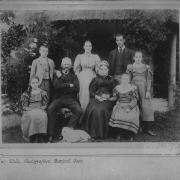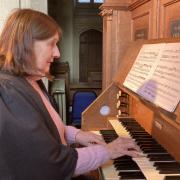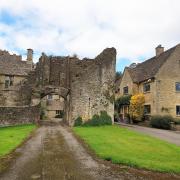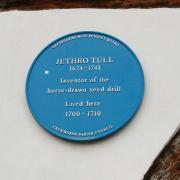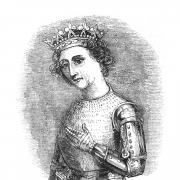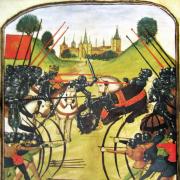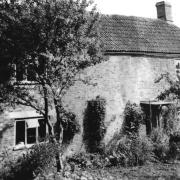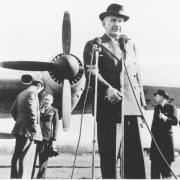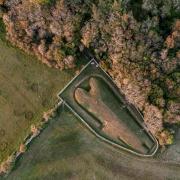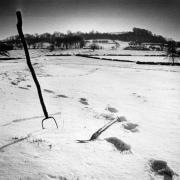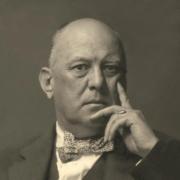The team at Gloucestershire Archives dust off the documents
Two for joy
This is the old ‘Three Magpies’ public house on the Fairford-Cirencester Road, north-east of Meysey Hampton, in 1910. The photograph was taken simply because of a coincidence in that the black blob in the tree on the upper right was a magpie nest and the landlord at the time was a Mr Sparrow. The inn was purpose built in 1830 to serve passing traffic on the main road and was originally called the Millers Arms, possibly because it was owned by Thomas Miller. By 1839 however it had become the Three Magpies and although still owned by Miller, it was occupied by Stephen Price, who was the landlord. By 1842, the pub had been bought by the Cirencester Brewery and when the latter was sold to the brewers H & G Simonds of Reading, the Three Magpies was included as one of the licensed premises. It remained open until 1952 when the brewery decided to close it, with the last landlord being Mr Maddock. A Grade II-listed building, it is sadly derelict today, but its situation was unique in that it was located at the most northerly point of Wiltshire, and it was said that one end of the bar was in Wiltshire and the other end in Gloucestershire!

Spotlight on Maps
You’d need a boat to cross these fields today as they form Lake 16 of the Cotswold Water Park – the home of South Cerney Sailing Club! The lakes around South Cerney are a relatively new phenomenon and just 200 years ago there was only open fields. This image is from the 1814 South Cerney Enclosure map and shows some of the 'Open and Common Fields, meadows, pastures and other lands' in the parish. The lakes were created in the second half of the 20th century by commercial extraction of glacial Jurassic limestone gravel found here. These gravels were formed when eroded material from the tops of the northern Cotswold Hills was washed down by floods in warm periods during the last Ice Ages, 350,000 and 45,000 years ago. These created wide braided rivers and streams that deposited gravel on the Thames Valley floor. As the workings began to become exhausted in the early 1970s, they filled up with water from local rivers (notably the River Churn) and streams. Today, as well as being used for leisure, they provide important habitats for all sorts of wildlife.

Seaplanes over the Severn?
In 1942, Gloucestershire County Council’s planning department was already thinking about post-WW2 reconstruction. Today, the reports and files are part of the County Council’s archive. Among them is this fascinating letter from G E Payne, the County Planning Officer, asking the Air Ministry whether the River Severn in Gloucestershire might have potential to become a seaplane base. Payne was chairman of the Forest of Dean Joint Planning Committee and was thinking of ways to boost the county’s transport links, especially with regards to air transport and the idea that post-war, trans-Atlantic passenger services would be by aircraft not ships. The Air Ministry’s Director of Operational Services & Intelligence replied with the pre-requisites – four runways 1½ miles (2.4km) long and set 45° apart, a minimum water depth of 2 fathoms (3.6m/12ft), a maximum wave height of 3ft (1m) in the landing area and an unobstructed approach allowing a glideslope of no more than 1 in 40 gradient. The director subtly mentioned that the Severn Estuary was rather exposed and, if feasible, then the RAF would have already established a flying boat station in the estuary. He also noted something that Payne had clearly forgotten, and which would cause havoc with anchored flying boats and flight schedules – the Severn Bore!

Gloucestershire Character
An animal character for the Summer Special – which the Cheltenham Chronicle & Gloucestershire Graphic published as ‘An Unusual Incident in Natural History’. This is a cat belonging to Mr Charles Neale of Grigshot, Woodchester, near Stroud, which clearly displayed a strong mothering instinct, as many female cats do. This moggy adopted and successfully suckled two fox cubs that had been taken from their mother. The magazine doesn’t say how this situation came about but it was probably the result of the mother fox being shot or the cubs being dug out of a den. Charles was seemingly an estate worker, which may explain why he had the cubs. Interestingly, although the relationship between foxes and cats is generally one of standoffishness or mutual tolerance (‘…but don’t come too close to me’), it can extend to a deeper relationship and cats often become surrogate parents to abandoned fox cubs. In a 1935 paper to the Proceedings of the Zoological Society of London, the authors noted that ‘fox cubs are reared quite well by cats...’. Whatever the story behind the picture, the mother and babies appear to be doing well.
Gloucestershire Archives, Clarence Row, Alvin Street, Gloucester, GL1 3DW, gloucestershire.gov.uk/archives
Beginning in June, Gloucestershire Heritage Hub will open one Saturday a month for special events, starting on Saturday, June 25 as part of the Kingsholm & Wotton Neighbourhood Partnership’s ‘Open Garden’ day. Visit the Heritage Hub’s beautiful community garden where there will be family-friendly garden games and activities, a digital display of royalty-themed documents from Gloucestershire Archives’ collections, and experts from Gloucestershire Family History Society on hand to help with your family history. The event runs from 11am to 4pm and there will be free refreshments. See www.heritagehub.org.uk for more information.




